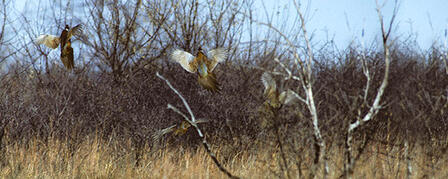KANSAS PHEASANT AND QUAIL SEASONS GENERATE EXCITEMENT

Nov. 7, 2013
Hunters return each fall to reconnect with land, friends, family and hunting traditions
PRATT – The Kansas pheasant and quail seasons open Saturday, Nov. 9, 2013-Jan. 31, 2014 and you can bet avid bird hunters will be in the field. It’s a time-honored tradition where spending time with friends and family, renewing acquaintances with landowners, and experiencing the Kansas countryside becomes more important than the number of birds bagged.
While the extended severe drought was broken this summer in many parts of the state, rains came too late to have significant impacts on pheasant nesting and brood survival success. The forecast for most of the traditional pheasant regions in Kansas predicts below average bird numbers. Rains have improved habitat conditions in many areas, and if the trend continues, nesting and brood habitat will be much better this spring.
There are pockets with decent pheasant numbers in the northcentral and northwestern regions of Kansas. Hunters will have to work to find birds, and they may have to travel within the regions to locate these pockets.
Quail populations in eastern Kansas have improved and some of the best quail hunting will be found in the Flint Hills and southeast regions of the state.
For more details on the pheasant, quail and prairie chicken forecast for 2013, go to www.ksoutdoors.com. A copy of the 2013 Kansas Hunting and Furharvesting Regulations Summary and the 2013 Kansas Hunting Atlas can be downloaded, as well. Printed publications are available wherever licenses are sold. More than 1 million acres are enrolled in the Walk-In Hunting Access (WIHA) program, and the atlas includes maps showing all WIHA tracts, as well as all state and federal public hunting lands.
Pheasant and quail hunters should remember that they must have permission to hunt private land, whether that land is posted or not. Land marked with purple paint requires written permission from the landowner. All resident hunters age 16-74 must have a Kansas resident hunting license, and all hunters born on or after July 1, 1957 must have completed an approved hunter education course. Youth 15 and younger may hunt without hunter education as long as they are under the direct supervision of an adult. Hunters 16 and older may purchase an apprentice license that is a one-time purchase and allows them to hunt without hunter education while also under adult supervision. A resident hunting license is $20.50. A resident youth multi-year license, valid from age 16-21, is available for $42.50. Resident hunters age 65-74 can purchase an annual hunting license for $11.50 or a lifetime combination hunt/fish license for $42.50. A nonresident hunting license is $72.50 for hunters 16 and older and $37.50 for youth hunters 15 and younger.
While hunting is one of the safest outdoor activities, simple safety precautions will ensure you have a safe and enjoyable hunt. Most hunting-related incidents in Kansas occur when a hunter swinging on game fires and hits another hunter in the line of fire. Maintaining safe zones of fire, keeping track of other hunters in your party, and wearing blaze orange clothing can help prevent this type of incident. Other safety rules include: always point your shotgun’s muzzle in a safe direction; keep your safety on until right before you shoot; know your target and what is beyond, and transport your shotgun unloaded and in a case.
-30-









